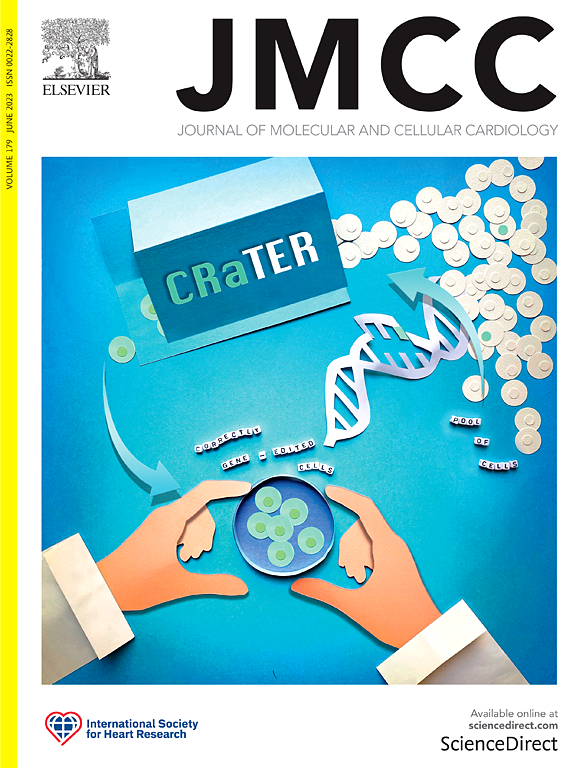ip3释放的肌醇1,4,5 -三磷酸受体结合蛋白(IRBIT)的过度表达诱导心肌肥大。
IF 4.7
2区 医学
Q1 CARDIAC & CARDIOVASCULAR SYSTEMS
引用次数: 0
摘要
IRBIT,也被称为ahcy1,是一种IP3受体(IP3R)结合蛋白,与IP3一起释放,最初被描述为上述受体的竞争性抑制剂。研究表明,在人和动物模型中,IP3Rs的过表达与心脏肥厚有关。鉴于IP3Rs在心脏肥厚中发挥作用,IRBIT也可能参与这种情况。目的:虽然IRBIT在心脏有表达报道,但其在心脏组织中的功能尚不清楚。因此,我们旨在研究上调和下调IRBIT对心脏预后的影响,以确定其病理生理作用。方法和结果:我们发现IRBIT在小鼠心室和心房、新生小鼠分离的成纤维细胞和心肌细胞以及成肌细胞系H9c2中表达。主动脉横缩小鼠IRBIT mRNA和蛋白表达均显著升高。此外,我们描述了IRBIT在扩张型和缺血性心肌病心肌样本中的差异表达。使用腺相关病毒(AAV9)在两个不同时间点(新生小鼠,第4天和成年小鼠,3 个月)的小鼠心脏中过度表达IRBIT导致心脏肥大,并在4个月大时收缩功能受损。在两种模型中也观察到IP3受体mRNA水平的降低。从irbit过表达的新生儿模型中分离的肌细胞显示Ca2+瞬态幅度显著降低,整体Ca2+瞬态上升较慢,而肌浆网(SR) Ca2+含量或自发Ca2+波频率没有变化。然而,Ca2+波的传播速度降低。此外,我们发现IRBIT过表达后,不同步指数(DI)显著升高。评估核Ca2+动力学,没有显示显着变化,但IRBIT过表达减少了核膜内陷的数量。此外,使用AAV9-shRNA降低IRBIT表达并不会导致心脏形态计量参数的任何变化。结论:我们的研究首次描述了IRBIT在心脏病理生理中起关键作用。我们的研究结果表明,IRBIT过表达破坏Ca2+信号,导致肥厚重塑和心功能受损。波传播的改变、DI的增加和Ca2+瞬态速率的降低表明IRBIT影响Ca2+ - 诱导的Ca2+释放。这项研究提供了IRBIT与病理性心脏重塑和Ca2+处理失调有关的第一个证据。虽然已经取得了重大进展,但为了更好地了解IRBIT的心血管功能及其机制,还需要进一步的研究。本文章由计算机程序翻译,如有差异,请以英文原文为准。

Cardiac hypertrophy induced by overexpression of IP3-released inositol 1, 4, 5-trisphosphate receptor-binding protein (IRBIT)
Introduction
IRBIT, also known as Ahcyl1, is an IP3 receptor (IP3R)-binding protein released with IP3 and was first described as a competitive inhibitor of the mentioned receptor. Studies have shown that overexpression of IP3Rs is associated with cardiac hypertrophy in both human and animal models. Given that IP3Rs play a role in cardiac hypertrophy, IRBIT may also be involved in this condition.
Aim
Although IRBIT heart expression has been reported, its function in cardiac tissues remains unclear. Thus, we aimed to study the cardiac outcomes of up-and downregulation of IRBIT to establish its pathophysiological role.
Methods and results
We found that IRBIT is expressed in mouse ventricles and atria, fibroblasts and cardiomyocytes isolated from neonatal mice, and in the myoblast cell line H9c2. Mice with transverse aortic constriction showed a significant increase in both the mRNA and protein expression of IRBIT. Furthermore, we described the differential expression of IRBIT in human myocardial samples of dilated and ischemic cardiomyopathy. IRBIT cardiac overexpression in mice using an adenoassociated virus (AAV9) at two different time points (neonatal mice, day 4 and adult mice, 3 months) resulted in the development of cardiac hypertrophy with impaired systolic function by four months of age. A decrease in the mRNA levels of the IP3 receptor was also observed in both models. Isolated myocytes from the IRBIT-overexpressing neonatal model showed a significantly decreased Ca2+ transient amplitude and slower rise of the global Ca2+ transient, without changes in sarcoplasmic reticulum (SR) Ca2+ content or spontaneous Ca2+ wave frequency. However, the velocity of Ca2+ wave propagation was reduced. Moreover, we found that the dyssynchrony index (DI) is significantly increased under IRBIT overexpression. Nuclear Ca2+ dynamics were assessed, showing no significant changes, but IRBIT overexpression reduced the number of nuclear envelope invaginations. In addition, reducing IRBIT expression using AAV9-shRNA did not result in any changes in the heart morphometric parameters.
Conclusion
Our study describes for the first time that IRBIT plays a critical role in the pathophysiology of the heart. Our findings demonstrate that IRBIT overexpression disrupts Ca2+ signaling, contributing to hypertrophic remodeling and impaired cardiac function. The altered wave propagation, the increase in DI and the decrease of the rate of the Ca2+ transient suggests that IRBIT influences Ca2+ − induced Ca2+ release. This study provides the first evidence linking IRBIT to pathological cardiac remodeling and Ca2+ handling dysregulation. Although significant progress has been made, further research is required to better understand the cardiovascular function of IRBIT and its mechanisms.
求助全文
通过发布文献求助,成功后即可免费获取论文全文。
去求助
来源期刊
CiteScore
10.70
自引率
0.00%
发文量
171
审稿时长
42 days
期刊介绍:
The Journal of Molecular and Cellular Cardiology publishes work advancing knowledge of the mechanisms responsible for both normal and diseased cardiovascular function. To this end papers are published in all relevant areas. These include (but are not limited to): structural biology; genetics; proteomics; morphology; stem cells; molecular biology; metabolism; biophysics; bioengineering; computational modeling and systems analysis; electrophysiology; pharmacology and physiology. Papers are encouraged with both basic and translational approaches. The journal is directed not only to basic scientists but also to clinical cardiologists who wish to follow the rapidly advancing frontiers of basic knowledge of the heart and circulation.

 求助内容:
求助内容: 应助结果提醒方式:
应助结果提醒方式:


